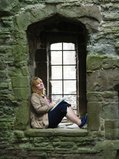Dolbadarn Castle, Gwynedd
~ History ~
1201 - Llywelyn ab Iorwerth (Llywelyn the Great) sweeps away all the ruling welsh opposition of his uncles and cousins to become ruler of Gwynedd. Later the same year his position is further strengthened by a treaty with King John who recognises Llywelyn's title to all the lands which he rules in north Wales.
1205 - Llywelyn marries King John's illegitimate daughter Joan.
1210 - The supremacy of Gwynedd over native Wales is firmly established, making Llywelyn the real power in Wales. In doing so he incurs the wrath of King John.
1211 - Only King John's political problems in England saves Llywelyn from total defeat.
1218 - Llywelyn achieves complete control over native Wales.
1230's - The building of the main tower at Dolbadarn, within an existing native castle is modelled on the latest English examples, begins.
1240 - Llywelyn the Great dies.
1247 - Dafydd, Llywelyn's son dies. Continued loss of Welsh territory culminates in the signing of the Treaty of Woodstock with King Henry III.
1255 - Llywelyn ap Gruffudd (Llywelyn the Last) defeats his brothers, Owain and Dafydd in the battle of Bryn Derwin. Owain is imprisoned at Dolbadarn for the next 22 years.
1267 - Llywelyn's position as Prince of all Wales is recognised by King Henry III in the treaty of Montgomery.
1277 - Llywelyn suffers a humiliating defeat at the hands of the new King, Edward I. Under the ensuring Treaty of Aberconwy, Gwynedd is again reduced to its lands west of the river Conwy.
Edward begins the building of four new Royal castle's at Aberystwyth, Builth, Flint and Rhuddlan. The king's hand and resources are also involved in at least three other constructions, at Hawarden, Hope & Ruthin.
As the walls if these new strongholds begin to rise in the landscape, King Edward sets about consolidating his political position in Wales. In existing castles on the frontiers, his loyal lieutenants soon extend their legal authority aggressively over the surrounding countryside. Llywelyn shows restraint, not so his brother.
1282 - March 21st, Dafydd, insubordinate brother to Llywelyn, attacks Hawarden castle. Now faced with an impossible dilemma, torn between his fealty to King Edward and his loyalty to Dafydd and his people, Llywelyn sides with his brother. War is declared. By the end of December the same year, Llywelyn is killed in a minor engagement with English forces near Builth Wells.
1283 - Late January, Edward's forces cross into Gwynedd, laying siege to Dolwyddelan Castle. The castle falls within days. Crucial route ways across the Snowdonia mountainous strongholds are secured.
Criccieth Castle, too, is soon in the hands of the English. Dafydd, who had started the war and was now the leader of the Welsh upon his brothers death, heads south towards Castell y Bere.
In March, in the face of overwhelming forces, and with a dwindling band of followers, Dafydd chooses not to join the Welsh defenders at Castell y Bere, and instead flees back to Snowdonia.
On 25th April 1283, with no hope of relief from Dafydd, the Welsh surrender the castle.
On 2nd May Dafydd issues two further deeds from Dolbadarn castle in an attempt to recover the situation.
Edward despatches 7,000 troops to hunt down Dafydd. It is not until 21st June that Dafydd is brought before the King at Rhuddlan castle, having being taken there 'by men of his own tongue'.
Dafydd is mercilessly sentenced to a gruesome death, being hanged, drawn and quartered at Shrewsbury.
Location | 1 mile Southeast of Llanberis, 7.5 miles East of Caernarfon |
Road | A4086 |
SatNav | LL55 4TA |
Huge steep-sided mountains loom on both sides of the Llanberis Pass as the road winds down towards Caernarfon and the coast. Here can be found Dolbadarn Castle, still standing sentinel to the route it once guarded. When Llywelyn the Last retreated to his mountain stronghold to escape King Edward I, the Llanberis Pass was the main route to the farm lands of Anglesey, whence most of the Welsh supplies came.
Dolbadarn Castle has to be one of the most iconic and beautifully set castles in all of Wales, if not the whole country. The scenery is simply stunning. An absolute must see for any castle-finder.






